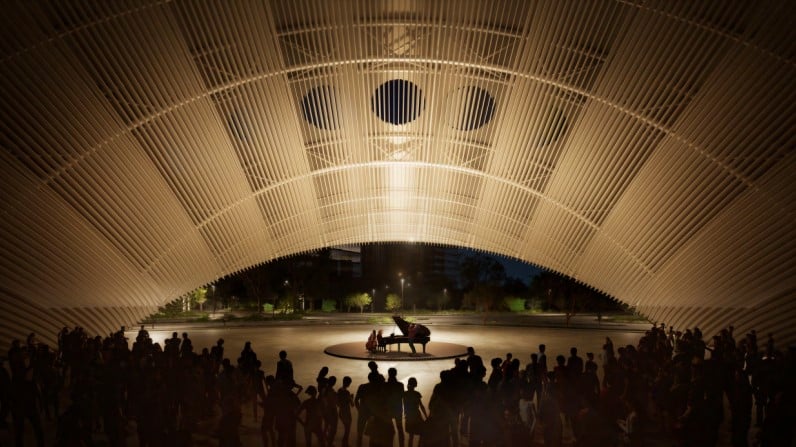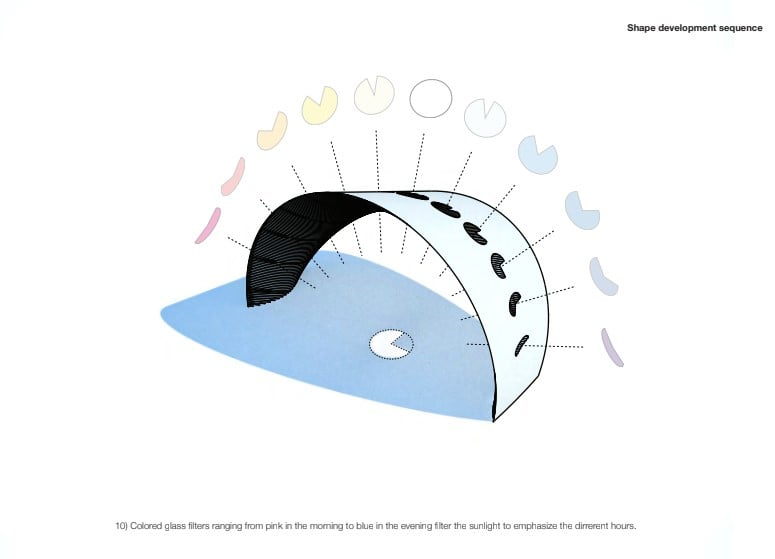A new public artwork called Arco del Tiempo, or Arch of Time, will generate clean energy for Texans still rebuilding after the devastation caused by Hurricane Harvey in 2017.
City of Houston officials have accepted a proposal from German architect Riccardo Mariano for the massive, futuristic installation developed with the Land Art Generator, a nonprofit organization that seeks to advance human-focused public art. renewable energies.
Mariano said he expects the arch, when complete, to be covered in solar panels that will produce 400 megawatts of electricity per hour, or about a quarter of what an average home in Texas uses in a year.
The energy generated will first go to Houston’s Talento Bilingue, a bilingual English-Spanish theater in the East End near Guadalupe Plaza Park where the public artwork will be placed.
“This institution, which is very important to Houston, will have zero energy bills,” Robert Ferry, co-director of Land Art Generator, told Artnet News. He added that any additional power will go first to lights and other park services, whatever the City of Houston has left. The team did not provide a timeline for the sculpture’s completion.

A rendering of a concert under the Arch of Time. Photo courtesy of Riccardo Mariano.
The creation of the Arco del Tiempo comes as Houston officials seek to connect Guadalupe Plaza Park, renovated in 2016, and Buffalo Bayou Park, created in 2015. Although both parks were completed before Hurricane Harvey , officials are using park designs to combat flooding.
“The mayor and the city had already done an extensive community pledge and they asked for public art and the symbol of an arch appeared in their pledge,” Ferry said. “The city is really investing in building the east end and avoiding development pitfalls and investing in east Buffalo Bayou. Riccardo’s work is kind of a gateway to that and hits a lot of the boxes really well.
Ferry said the designers expect the giant sculpture to attract “considerable new development” to the edges of the park and believe it will be net positive energy output within five years. The sculpture is expected to remain on the site for at least 25 years.
“This is the world’s first public artwork designed to make a net positive contribution to the climate crisis,” Mariano said in a statement.

A diagram shows how colored glass and shapes are used to tell time with the giant sundial. Photo courtesy of Riccardo Mariano
Mariano based his design on the concept of the sundial, the oldest known device for measuring time.
“The sun is the source of life on Earth and that’s what I thought when I designed it,” he said, adding that the ark would shoot beams of light onto the ground as if they were seen through a prism that varied depending on the time of day. “It’s very accessible and engaging art for the public.”
Mariano said the arch’s shape is influenced by its function, following the path of the sun across the Texas sky to increase its power generation efficiency. The architect tested the sundial function using a smaller-scale model that Ferry described as “the art in [and] of herself.
“The shape follows the apparent path of the Sun over the day and year, modified to optimize energy production, and tapers towards sunset and sunrise, which is how the shape was It’s a very functional form that also becomes monumental,” he said.
He added that the sun can be “very intense” in Texas, so it also provides shade and allows people to spend time outdoors.
The arch could be considered a triumph for the city of Houston, but Mariano disliked any connection to triumphal arches like the Arc du Triomphe in Paris or the arch in Washington Square Park in New York.
“There is no relation to triumphal arches and I wouldn’t want to have that connection because these were usually erected after winning wars,” he said.
“I would rather think of the Pantheon, which has arches that light up different parts of the building depending on the time of year. It is a source of inspiration.
More trending stories:
A Norwegian father hiking with his family discovered a rock wall covered in Bronze Age paintings
Gnarled old tooth found in museum cabinet may hold key to understanding ancient hippo relative
Israeli first-grader stumbled across 3,500-year-old Egyptian amulet on school trip
Follow Artnet News on Facebook:
Want to stay one step ahead of the art world? Subscribe to our newsletter to receive breaking news, revealing interviews and incisive reviews that move the conversation forward.
